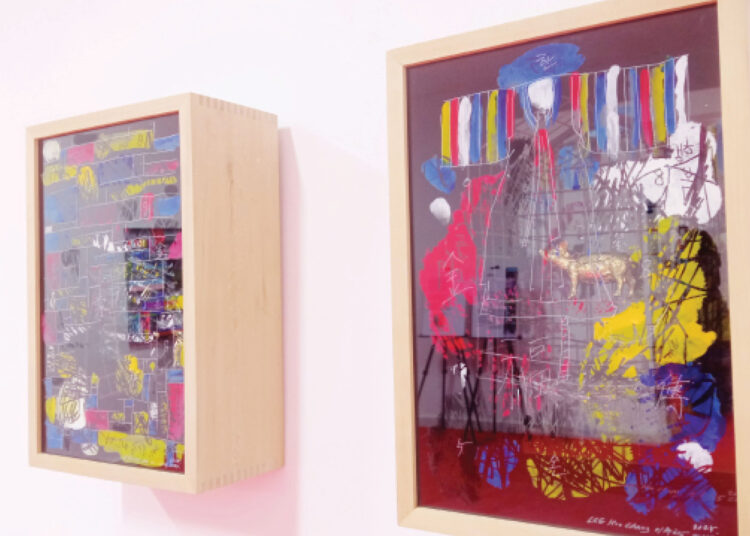The exhibition, ‘Hanbok, Reimagined As Art’, highlights the role of (visual) ‘art’ in the innovation and contemporizing of the traditional for global appeal and consumption.
Curated by Han Sang-Ik of Savina Contemporary Museum of Art for the Korean Ministry of Culture, Youth and Sports, and exhibited at the occasion of the 15th anniversary of the Korea Culture Center Nigeria (KCCN), ‘Hanbok, Reimagined As Art’ featuring 34 works by 11 artists, aims at introducing the global art audience to the Korea traditional clothing ‘Hanbok’, to convey the value of culture to future generations, and highlight the possibilities that abound at the intersection of tradition and modernity.
The choice of ‘art’ to attain the aforementioned objectives isn’t surprising, as art has always been at the forefront of global movements – from renaissance to impression, to industrial and now information technology age.
As the traditional clothing of Koreans, the Hanbok dates back to the three kingdoms of Korea (Gorguryeo, Paekche and Silla), and has evolved in shape, design and function through time. Within the last two decades, Korean fashion designers have brought the Hanbok to limelight by lending a contemporary take to the traditional garb.
But ‘Hanbok, Reimagined As Art’ does much more than just altering the cut, or maneuvering fabrics used in making Hanbok. First, It explores new artistic values – by deconstructing and reconstructing elements of the Hanbok such as the colours of the Obangsaek (the five cardinal colours representing directional symbolism based on the yin-yang and the five elements philosophy), the Saekdong – (a pattern created by joining fabrics of various colours or weaving fabric to create an appearance of a Jeogori (traditional Korean jacket with multicoloured sleeves), and the traditional motifs of the Hanbok such as – (gold-leaf, dragons, peons, chrysanthemums, phoenixes, kirins, etc.), to create new designs and patterns as seen in Kwon Ki Soo’s ‘Nice Dream Pink’ (2023), and Yang Dae Won’s ‘Love Red I’ (2023) and ‘Love Red III’ (2023).
Similarly, via digitally reconstructed versions of himself attired in diverse styles of Joseon era male hanboks which signifies various classes, offices and royalty, and of female court dancers (Yeoryeong) decked in Seonyurak costumes, Lee Joong Keun, utilizes deepfake synthesis among other digital tools to arrange these images into fabric-like patterns that take-on an abstract form when viewed from afar, but highlights the details of the Hanboks on closer inspection.
Lee Don Ah’s optical illusory works blends the past and the present as a symbolism of the continuity of the Hanbok. In ‘Preciousness’ (2024) – Ah deploys the Hanbok as a backdrop for a Silla Dynasty crown adding to the general aesthetic of the image. ‘Prosperity’ (2024) points to long history of the Hanbok – in particular the Hanbok of the Goguryeo Kingdom, whose wide-legged pants have made a comeback in contemporary male Hanboks. Then there’s the Chosun ceramic piece ‘Space, Time, Continuum – Chosun Dynasty’ (2024) which morphs into a royal Hanbok of same era, as one moves towards the image.
Kim Si Hyun’s hyper-realistic oil on canvas paintings ‘The Precious Message’ (2023) turns the mundane act of object wrapping and transportation to an experience of delightful expectation, by swapping the plain weave material (Nobang) of the Bojagi (square cloth for wrapping objects for delivery), for the luscious red, royal blue and multiple colours of the Saekdong Jeogori.
And who says Hanbok elements cannot be reinterpreted to represent hopeful aspirations and good wishes – as in Lee Ho Chang’s glass boxes ‘Comfort For Everyone I’ and ‘Comfort For Everyone II’. Both breaks down visually and analytically the Saekdong and Obangsaek colours on glass, that represent longevity and happiness, while the gold pig insets on both boxes symbolizes abundance and fortune. The perfect housewarming gift for a family.
Meantime, Jung Myoung Jo and Nam Kyung Min educate viewers on the different roles women played in historical Korea – as queen and ginyeos (female entertainer) in Kyung Min’s ‘Shin Saimdang’s Atelier’ and ‘Hwang Jin-Yi’s Atelier – A Dream of Ginyeo’. While both roles in society were vastly different, the paintings highlight their similarity in their passion for the arts – poetry & painting. Above all, it highlights how women express themselves and their individuality in a restrictive society through their hair ornaments, hanbok designs and styles as expressed in Myoung Jo’s hyper-realistic paintings ‘Playground’ and ‘The Paradox of Beauty’.
Nigeria can borrow a leaf from this exhibition not solely on how to promote the Nigerian locally produced traditional fabrics at the global stage, but ensure a symbiotic intersection where fashion feeds art and vice versa. This will ensure that our traditional fabric remain innovative, whilst telling our stories via the use of various ethnic-specific motifs, like Nike Okundaye Davies (aka Mama Nike) does with her local hand-made ‘Adire’ and ‘Aso Oke’.
The citing of the exhibition at the newly refurbished Textile Gallery section of the Nike Arts Gallery in Abuja is significant. The gallery was particularly created by the Arts and Crafts curator and promoter, to hold exhibitions showcasing textiles from across the country, and beyond.
While the funding for the ambitious project is non-existent, Nike Gallery calls for a funding from international organizations as UNESCO, the federal/state government sponsoring the gallery to employ researchers to document Nigeria’s locally crafted fabrics across the 36 states. The documentation of the nation’s locally crafted textiles is the first step to not just celebrating our culture, and engendering future collaborations with countries like Korea that are light years ahead of Nigeria in the documentation, archiving and preservation of their fabrics for posterity’s sake and for global consumption.




